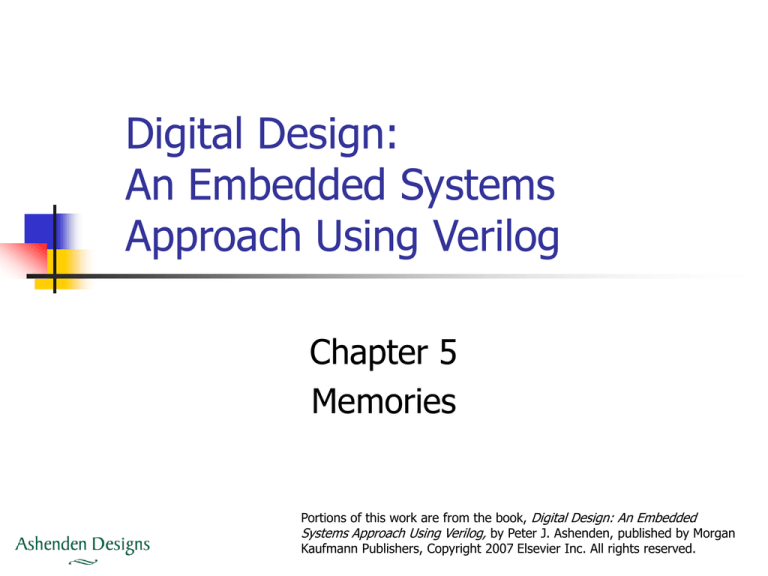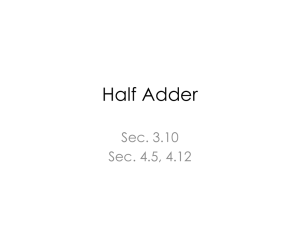
Digital Design:
An Embedded Systems
Approach Using Verilog
Chapter 5
Memories
Portions of this work are from the book, Digital Design: An Embedded
Systems Approach Using Verilog, by Peter J. Ashenden, published by Morgan
Kaufmann Publishers, Copyright 2007 Elsevier Inc. All rights reserved.
Verilog
General Concepts
A memory is an array of
storage locations
Address is unsigned-binary
encoded
Each with a unique address
Like a collection of
registers, but with optimized
implementation
n address bits ⇒ 2n locations
m bits
0
1
2
3
4
5
6
2n–2
2n–1
All locations the same size
2n × m bit memory
Digital Design — Chapter 5 — Memories
2
Verilog
Memory Sizes
Use power-of-2 multipliers
Example
Kilo (K): 210 = 1,024 ≈ 103
Mega (M): 220 = 1,048,576 ≈ 106
Giga (G): 230 = 1,073,741,824 ≈ 109
32K × 32-bit memory
Capacity = 1,025K = 1Mbit
Requires 15 address bits
Size is determined by application
requirements
Digital Design — Chapter 5 — Memories
3
Verilog
Basic Memory Operations
a inputs: unsigned address
d_in and d_out
a(0)
a(1)
…
…
…
…
…
d_in(m–1)
d_out(0)
d_out(1)
d_out(m–1)
…
d_in(0)
d_in(1)
Write operation
a(n–1)
en
wr
en = 1, wr = 1
d_in value stored in location given
by address inputs
Read operation
Type depends on application
en = 1, wr = 0
d_out driven with value of location
given by address inputs
Idle: en = 0
Digital Design — Chapter 5 — Memories
4
Verilog
Example: Audio Delay Unit
System clock: 1MHz
Audio samples: 8-bit signed, at 50kHz
New sample arrives when audio_in_en = 1
Delay control: 8-bit unsigned ⇒ ms to delay
Output: audio_out_en = 1 when output ready
Digital Design — Chapter 5 — Memories
5
Verilog
Audio Delay Datapath
count_en
en
clk
Q
14
clk
0
delay
addr_sel
audio_in
mem_en
mem_wr
8
×50
14
–
1
14
a
d_in d_out
16
audio_out
en
wr
16
Max delay = 255ms
Need to store 255 × 50 = 12,750 samples
Use a 16K × 8-bit memory (14 address bits)
Digital Design — Chapter 5 — Memories
6
Verilog
Audio Delay Control Section
Step 1: (idle state)
audio_in_en = 0 ⇒ do nothing
audio_in_en = 1 ⇒ write memory using counter
value as address
Step 2:
Read memory using subtracter output as address,
increment counter
State
audio_
in_en
Next state
addr_sel
mem_en
mem_wr
count_en
audio_
out_en
Step 1
0
Step 1
0
0
0
0
0
Step 1
1
Step 2
0
1
1
0
0
Step 2
–
Step 1
1
1
0
1
1
Digital Design — Chapter 5 — Memories
7
Verilog
Wider Memories
Memory components have a fixed width
E.g., ×1, ×4, ×8, ×16, ...
Use memory
components in
parallel to make
a wider memory
E.g, three 16K×16
components for a
16K×48 memory
en
wr
a(13…0)
d_in(15…0)
en
wr
a(13…0)
d_in(15…0)
d_out(15…0)
d_out(15…0)
en
wr
d_in(31…16)
d_in(47…32)
a(13…0)
d_in(15…0)
d_out(15…0)
d_out(31…16)
en
wr
a(13…0)
d_in(15…0)
d_out(15…0)
d_out(47…32)
Digital Design — Chapter 5 — Memories
8
Verilog
More Locations
To provide 2n locations with
2k-location components
Use 2n/2k components
Address A
at offset A mod 2k
least-significant k bits of A
in component A/2k
most-significant n–k bits of A
decode to select component
0
1
2k–1
2k
2k+1
2×2k–1
2×2k
2×2k+1
3×2k–1
2n–2k
2n–2k +1
2n–1
Digital Design — Chapter 5 — Memories
9
Verilog
More Locations
en
wr
wr
a(13…0)
a(13…0)
d_in(7…0)
en
a(15…14)
Example:
64K×8 memory
composed of
16K×8 components
d_in(7…0)
d_out(7…0)
en 0
1
2
3
en
wr
a(13…0)
d_in(7…0)
d_out(7…0)
en
wr
a(13…0)
0
1
2
3
d_out(7…0)
d_in(7…0)
d_out(7…0)
en
wr
a(13…0)
d_in(7…0)
d_out(7…0)
Digital Design — Chapter 5 — Memories
10
Verilog
Tristate Drivers
Allow multiple outputs to be connected together
Only one active at a time
Remaining outputs are high-impedance
Both output transistors turned off
Allow bidirectional input/output ports
+V
output
Digital Design — Chapter 5 — Memories
11
Verilog
Memories with Tristate Ports
During write
a(13…0)
d(7…0)
en
selected memory drives d
a(13…0)
a(15…14)
0
en 1
2
3
d(7…0)
a(13…0)
Reduced cost of PCB
Usually not available
within ASICs or FPGAs
en
wr
a(13…0)
en
wr
Fewer pins and wires
memory d drivers hi-Z
memory senses d
During read
en
wr
wr
d(7…0)
en
wr
d(7…0)
Digital Design — Chapter 5 — Memories
a(13…0)
d(7…0)
12
Verilog
Memory Types
Random-Access Memory (RAM)
Can read and write
Static RAM (SRAM)
Dynamic RAM (DRAM)
Needs to be periodically refreshed
Read-Only Memory (ROM)
Stores data so long as power is supplied
Asynchronous SRAM: not clocked
Synchronous SRAM (SSRAM): clocked
Combinational
Programmable and Flash rewritable
Volatile and non-volatile
Digital Design — Chapter 5 — Memories
13
Verilog
Asynchronous SRAM
Data stored in 1-bit latch cells
Address decoded to enable a given cell
Usually use active-low control inputs
Not available as components in ASICs or FPGAs
A
D
CE
WE
OE
Digital Design — Chapter 5 — Memories
14
Verilog
Asynch SRAM Timing
Timing parameters published in data sheets
Access time
Cycle time
From address/enable valid to data-out valid
From start to end of access
Data setup and hold
Before/after end of WE pulse
Makes asynch SRAMs hard to use in clocked
synchronous designs
Digital Design — Chapter 5 — Memories
15
Verilog
Example Data Sheet
Digital Design — Chapter 5 — Memories
16
Verilog
Synchronous SRAM (SSRAM)
Clocked storage registers for inputs
address, data and control inputs
stored on a clock edge
held for read/write cycle
Flow-through SSRAM
no register on
data output
clk
A
a1
a2
en
wr
D_in
xx
D_out
Digital Design — Chapter 5 — Memories
xx
M(a2)
17
Verilog
Example: Coefficient Multiplier
Compute function y ci x
Coefficient stored in flow-through SSRAM
12-bit unsigned integer index for i
x, y, ci 20-bit signed fixed-point
2
8 pre- and 8 post-binary point bits
Use a single multiplier
Multiply c × x × x
i
Digital Design — Chapter 5 — Memories
18
Verilog
Multiplier Datapath
SSRAM
i
c_in
A
D_in D_out
c_ram_en
en
c_ram_wr
wr
0
clk
x
x_ce
D
Q
1
×
0
1
ce
D
Q
y
ce
clk
clk
mult_sel
y_ce
clk
Digital Design — Chapter 5 — Memories
19
Verilog
Multiplier Timing and Control
0
step1
1
1, 1, 0, 0
step2
0, 0, 0, 1
step3
0, 0, 1, 1
Digital Design — Chapter 5 — Memories
20
Verilog
Pipelined SSRAM
Data output also has a register
More suitable for high-speed systems
Access RAM in one cycle, use the data in
the next cycle
clk
A
a1
a2
en
wr
D_in
D_out
xx
xx
M(a2)
Digital Design — Chapter 5 — Memories
21
Verilog
Memories in Verilog
RAM storage represented by an array variable
reg [15:0] data_RAM [0:4095];
...
always @(posedge clk)
if (en)
if (wr) begin
data_RAM[a] <= d_in; d_out <= d_in;
end
else
d_out <= data_RAM[a];
Digital Design — Chapter 5 — Memories
22
Verilog
Example: Coefficient Multiplier
module scaled_square ( output reg signed [7:-12]
input
signed [7:-12]
input
[11:0]
input
input
y,
c_in, x,
i,
start,
clk, reset );
wire
c_ram_wr;
reg
c_ram_en, x_ce, mult_sel, y_ce;
reg signed [7:-12] c_out, x_out;
reg signed [7:-12] c_RAM [0:4095];
reg signed [7:-12] operand1, operand2;
parameter [1:0] step1 = 2'b00, step2 = 2'b01, step3 = 2'b10;
reg
[1:0] current_state, next_state;
assign c_ram_wr = 1'b0;
Digital Design — Chapter 5 — Memories
23
Verilog
Example: Coefficient Multiplier
always @(posedge clk) // c RAM - flow through
if (c_ram_en)
if (c_ram_wr) begin
c_RAM[i] <= c_in;
c_out
<= c_in;
end
else
c_out <= c_RAM[i];
always @(posedge clk) // y register
if (y_ce) begin
if (!mult_sel) begin
operand1 = c_out;
operand2 = x_out;
end
else begin
operand1 = x_out;
operand2 = y;
end
y <= operand1 * operand2;
end
Digital Design — Chapter 5 — Memories
24
Verilog
Example: Coefficient Multiplier
always @(posedge clk)
...
always @*
...
// State register
// Next-state logic
always @* begin
...
// Output logic
endmodule
Digital Design — Chapter 5 — Memories
25
Verilog
Pipelined SSRAM in Verilog
reg
pipelined_en;
reg [15:0] pipelined_d_out;
...
output
always @(posedge clk) begin
register
if (pipelined_en) d_out <= pipelined_d_out;
pipelined_en <= en;
if (en)
if (wr) begin
data_RAM([a] <= d_in; pipelined_d_out <= d_in;
end
else
pipelined_d_out <= data_RAM[a];
SSRAM
end
Digital Design — Chapter 5 — Memories
26
Verilog
Generating SSRAM Components
Variations on SSRAM behavior
E.g., write-first, read-first or no-change on
write cycle
Burst accesses to successive locations
Not all synthesis tools recognize the
same templates
Use a RAM core generator tool
Digital Design — Chapter 5 — Memories
27
Verilog
Example: RAM Core Generator
Digital Design — Chapter 5 — Memories
28
Verilog
Multiport Memories
Multiple address, data and control
connections to the storage locations
Allows concurrent accesses
Scenario
Avoids multiplexing and sequencing
Data producer and data consumer
What if two writes to a location occur
concurrently?
Result may be unpredictable
Some multi-port memories include an arbiter
Digital Design — Chapter 5 — Memories
29
Verilog
FIFO Memories
First-In/First-Out buffer
Connecting producer and consumer
Decouples rates of production/consumption
Producer
subsystem
Consumer
subsystem
FIFO
Implementation using
dual-port RAM
Circular buffer
Full: write-addr = read-addr
Empty: write-addr = read-addr
read
write
Digital Design — Chapter 5 — Memories
30
Verilog
Example: FIFO Datapath
rd_en
counter
8-bit
ce
Q
A_rd
reset
=
clk
counter
8-bit
ce
Q
reset
A_wr
reset
clk
dual-port
SSRAM
A_wr A_rd
D_wr
D_rd
D_rd
wr_en rd_en
clk
D_wr
wr_en
clk
equal
clk
Equal = full or empty
Need to distinguish between these states — How?
Digital Design — Chapter 5 — Memories
31
Verilog
Example: FIFO Control
Control FSM
→ filling when write without concurrent read
→ emptying when without concurrent write
Unchanged when concurrent write and read
emptying
wr_en, rd_en
1, 0
0, 1
full = filling and equal
empty = emptying and equal
filling
Digital Design — Chapter 5 — Memories
32
Verilog
Multiple Clock Domains
Need to resynchronize data that
traverses clock domains
Use resynchronizing registers
May overrun if sender's clock is faster
than receiver's clock
FIFO smooths out differences in data
flow rates
Latch cells inside FIFO RAM written with
sender's clock, read with receiver's clock
Digital Design — Chapter 5 — Memories
33
Verilog
Dynamic RAM (DRAM)
Data stored in a 1-transistor/1-capacitor cell
Write operation
Smaller cell than SRAM, so more per chip
But longer access time
pull bit-line high or low (0 or 1)
activate word line
Read operation
precharge bit-line to intermediate voltage
activate word line, and sense charge equalization
rewrite to restore charge
Digital Design — Chapter 5 — Memories
34
Verilog
DRAM Refresh
Charge on capacitor decays over time
Need to sense and rewrite periodically
Refresh each location
DRAMs organized into banks of rows
Typically every cell every 64ms
Refresh whole row at a time
Can’t access while refreshing
Interleave refresh among accesses
Or burst refresh every 64ms
Digital Design — Chapter 5 — Memories
35
Verilog
Read-Only Memory (ROM)
For constant data, or CPU programs
Masked ROM
Programmable ROM (PROM)
Data manufactured into the ROM
Use a PROM programmer
Erasable PROM (EPROM)
UV erasable
Electrically erasable (EEPROM)
Flash RAM
Digital Design — Chapter 5 — Memories
36
Verilog
Combinational ROM
A ROM maps address input to data output
BCD0
BCD1
BCD2
BCD3
blank
This is a combinational function!
Specify using a table
Example: 7-segment decoder
A0
A1
A2
A3
A4
D0
D1
D2
D3
D4
D5
D6
a
b
c
d
e
f
g
Address
Content
Address
Content
0
0111111
6
1111101
1
0000110
7
0000111
2
1011011
8
1111111
3
1001111
9
1101111
4
1100110
10–15
1000000
5
1101101
16–31
0000000
Digital Design — Chapter 5 — Memories
37
Verilog
Example: ROM in Verilog
module seven_seg_decoder ( output reg [7:1] seg,
input
[3:0] bcd,
input
blank );
always @*
case ({blank, bcd})
5'b00000: seg = 7'b0111111;
5'b00001: seg = 7'b0000110;
5'b00010: seg = 7'b1011011;
5'b00011: seg = 7'b1001111;
5'b00100: seg = 7'b1100110;
5'b00101: seg = 7'b1101101;
5'b00110: seg = 7'b1111101;
5'b00111: seg = 7'b0000111;
5'b01000: seg = 7'b1111111;
5'b01001: seg = 7'b1101111;
5'b01010, 5'b01011, 5'b01100,
5'b01101, 5'b01110, 5'b01111:
seg = 7'b1000000;
default: seg = 7'b0000000;
endcase
//
//
//
//
//
//
//
//
//
//
0
1
2
3
4
5
6
7
8
9
// "-" for invalid code
// blank
endmodule
Digital Design — Chapter 5 — Memories
38
Verilog
Flash RAM
Non-volatile, readable (relatively fast), writable
(relatively slow)
Storage partitioned into blocks
NOR Flash
Erase a whole block at a time, then write/read
Once a location is written, can't rewrite until erased
Can write and read individual locations
Used for program storage, random-access data
NAND Flash
Denser, but can only write and read block at a time
Used for bulk data, e.g., cameras, memory sticks
Digital Design — Chapter 5 — Memories
39
Verilog
Memory Errors
Bits in memory can be flipped
Hard error
Soft error
The chip is broken
E.g., manufacturing defect, wear (in Flash)
Stored data corrupted, but cell still works
E.g., from atmospheric neutrons
Soft-error rate
frequency of occurrence
Digital Design — Chapter 5 — Memories
40
Verilog
Error Detection using Parity
Add a parity bit to each location
On write access
On read access
compute data parity and store with data
check parity, take exception on error
If we could tell which bit flipped
correct by flipping it back, then write back
to memory location
Can’t do this with parity
Digital Design — Chapter 5 — Memories
41
Verilog
Error-Correcting Codes (ECC)
Allow identification of the flipped bit
Hamming Codes
E.g., for single-bit-error correction of N-bit word,
need log2N + 1 extra bits
Example: 8-bit word, d1... d8
12-bit ECC code, e1...e12
e1, e2, e4, e8 are check bits, the rest data
d8
d7
d6
d5
d4
d3
d2
d1
e12 e11 e10
e9
e8
e7
e6
e5
e4
Digital Design — Chapter 5 — Memories
e3
e2
e1
42
Verilog
Hamming Code Example
d8
d7
d6
d5
d4
d3
d2
d1
e12 e11 e10
e9
e8
e7
e6
e5
e4
e1
0
0
0
1
e2
0
0
1
0
e4
0
1
0
0
e8
1
0
0
0
e3
0
0
1
1
e5
0
1
0
1
e6
0
1
1
0
e7
0
1
1
1
e9
1
0
0
1
e10
1
0
1
0
e11
1
0
1
1
e12
1
1
0
0
e1 = e3 ⊕ e5 ⊕ e7 ⊕ e9 ⊕ e11
e3
e2
e = e3 ⊕ e6 ⊕ e7 ⊕ e10 ⊕ e11
e1 2
e4 = e5 ⊕ e6 ⊕ e7 ⊕ e12
e8 = e9 ⊕ e10 ⊕ e11 ⊕ e12
Every data bit covered by two
or more check bits
On write: Compute check bits
and store with data
Digital Design — Chapter 5 — Memories
43
Verilog
Hamming Code Example
On read: Recompute check bits
and XOR with read check bits
0000 => no error
If data bit flipped
e1
0
0
0
1
e2
0
0
1
0
e4
0
1
0
0
e8
1
0
0
0
e3
0
0
1
1
e5
0
1
0
1
e6
0
1
1
0
e7
0
1
1
1
e9
1
0
0
1
e10
1
0
1
0
e11
1
0
1
1
e12
1
1
0
0
covering bits of syndrome are 1
= binary code of flipped ECC bit
If stored check bit flipped
result called the syndrome
that bit of syndrome is 1
On error, unflip bit and rewrite
memory location
Digital Design — Chapter 5 — Memories
44
Verilog
Multiple-Error Detection
What if two bits flip
syndrome identifies wrong bit, or is invalid
One extra check bit allows
single-error correction, double-error detection
Single-bit correction
Double-bit detection
N
Check bits
Overhead
Check bits
Overhead
8
4
50%
5
63%
16
5
31%
6
38%
32
6
19%
7
22%
64
7
11%
8
13%
128
8
6.3%
9
7.0%
256
9
3.5%
10
3.9%
Digital Design — Chapter 5 — Memories
45
Verilog
Summary
Memory: addressable storage locations
Read and Write operations
Asynchronous RAM
Synchronous RAM (SSRAM)
Dynamic RAM (DRAM)
Read-Only Memory (ROM) and Flash
Multiport RAM and FIFOs
Error Detection and Correction
Hamming Codes
Digital Design — Chapter 5 — Memories
46









